MGMT 6059 - Evaluating Walmart's Corporate Strategy using TNS Model
VerifiedAdded on 2023/06/08
|16
|3582
|307
Case Study
AI Summary
This case study report critically assesses the potential and limitations of The Natural Step (TNS) framework in informing Walmart's corporate strategy. It begins by introducing Walmart's global presence and its existing environmental sustainability policies. The report then delves into the principles of sustainable environmental development and examines Walmart's sustainability progress, including its goals for zero waste, renewable energy reliance, and environmentally sustainable products. It highlights Walmart's achievements in reducing greenhouse gas emissions and improving transport efficiency. The study also acknowledges the limitations faced by Walmart in implementing its sustainability initiatives, such as regulatory demands and budget constraints. Furthermore, it explores Porter's Competitive theory and innovation's role in sustainable development, emphasizing Walmart's commitment to circular economy principles and scientific justification in environmental protection. The report concludes by emphasizing the importance of legislative establishment and environmental planning in achieving sustainable business practices.
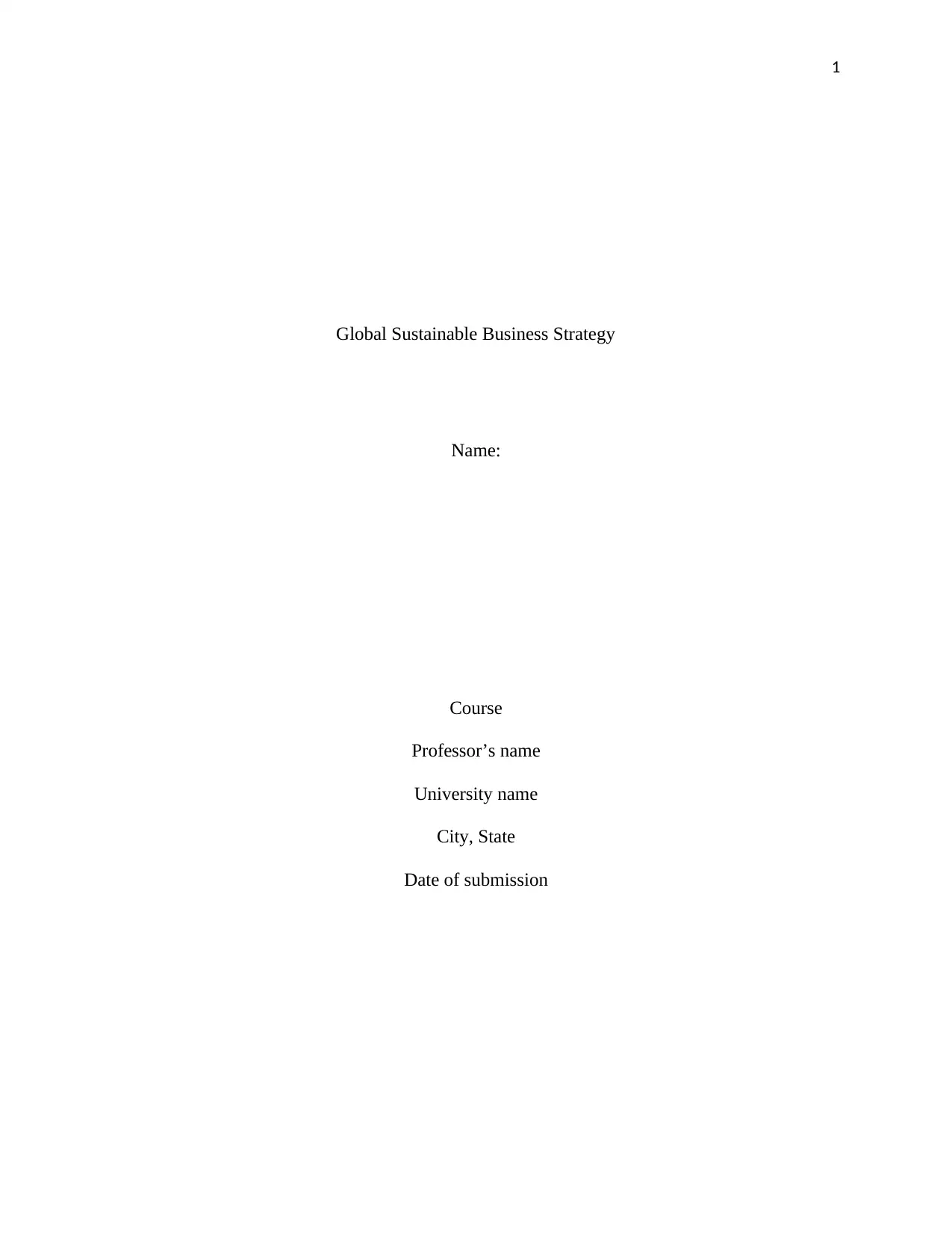
1
Global Sustainable Business Strategy
Name:
Course
Professor’s name
University name
City, State
Date of submission
Global Sustainable Business Strategy
Name:
Course
Professor’s name
University name
City, State
Date of submission
Paraphrase This Document
Need a fresh take? Get an instant paraphrase of this document with our AI Paraphraser
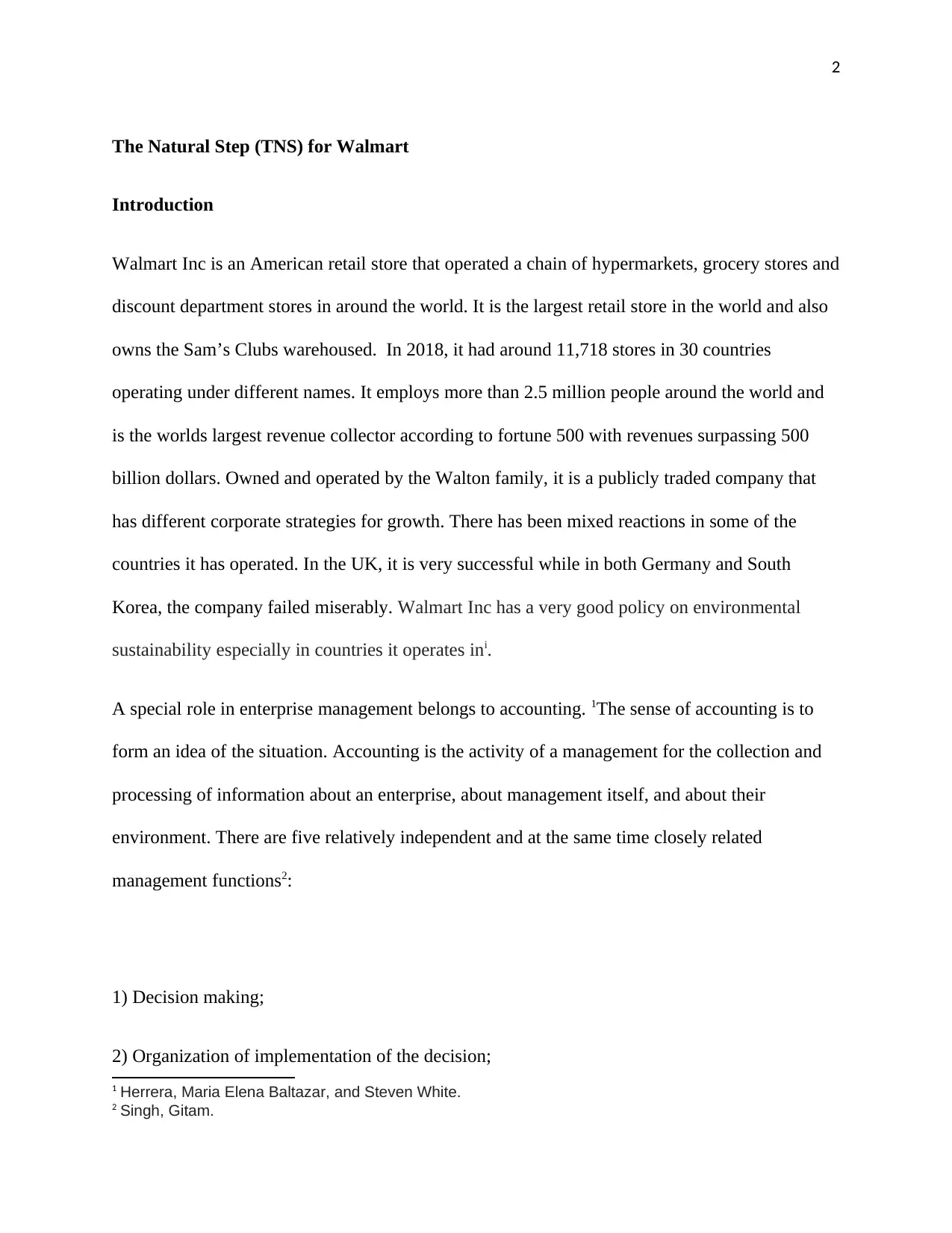
2
The Natural Step (TNS) for Walmart
Introduction
Walmart Inc is an American retail store that operated a chain of hypermarkets, grocery stores and
discount department stores in around the world. It is the largest retail store in the world and also
owns the Sam’s Clubs warehoused. In 2018, it had around 11,718 stores in 30 countries
operating under different names. It employs more than 2.5 million people around the world and
is the worlds largest revenue collector according to fortune 500 with revenues surpassing 500
billion dollars. Owned and operated by the Walton family, it is a publicly traded company that
has different corporate strategies for growth. There has been mixed reactions in some of the
countries it has operated. In the UK, it is very successful while in both Germany and South
Korea, the company failed miserably. Walmart Inc has a very good policy on environmental
sustainability especially in countries it operates ini.
A special role in enterprise management belongs to accounting. 1The sense of accounting is to
form an idea of the situation. Accounting is the activity of a management for the collection and
processing of information about an enterprise, about management itself, and about their
environment. There are five relatively independent and at the same time closely related
management functions2:
1) Decision making;
2) Organization of implementation of the decision;
1 Herrera, Maria Elena Baltazar, and Steven White.
2 Singh, Gitam.
The Natural Step (TNS) for Walmart
Introduction
Walmart Inc is an American retail store that operated a chain of hypermarkets, grocery stores and
discount department stores in around the world. It is the largest retail store in the world and also
owns the Sam’s Clubs warehoused. In 2018, it had around 11,718 stores in 30 countries
operating under different names. It employs more than 2.5 million people around the world and
is the worlds largest revenue collector according to fortune 500 with revenues surpassing 500
billion dollars. Owned and operated by the Walton family, it is a publicly traded company that
has different corporate strategies for growth. There has been mixed reactions in some of the
countries it has operated. In the UK, it is very successful while in both Germany and South
Korea, the company failed miserably. Walmart Inc has a very good policy on environmental
sustainability especially in countries it operates ini.
A special role in enterprise management belongs to accounting. 1The sense of accounting is to
form an idea of the situation. Accounting is the activity of a management for the collection and
processing of information about an enterprise, about management itself, and about their
environment. There are five relatively independent and at the same time closely related
management functions2:
1) Decision making;
2) Organization of implementation of the decision;
1 Herrera, Maria Elena Baltazar, and Steven White.
2 Singh, Gitam.
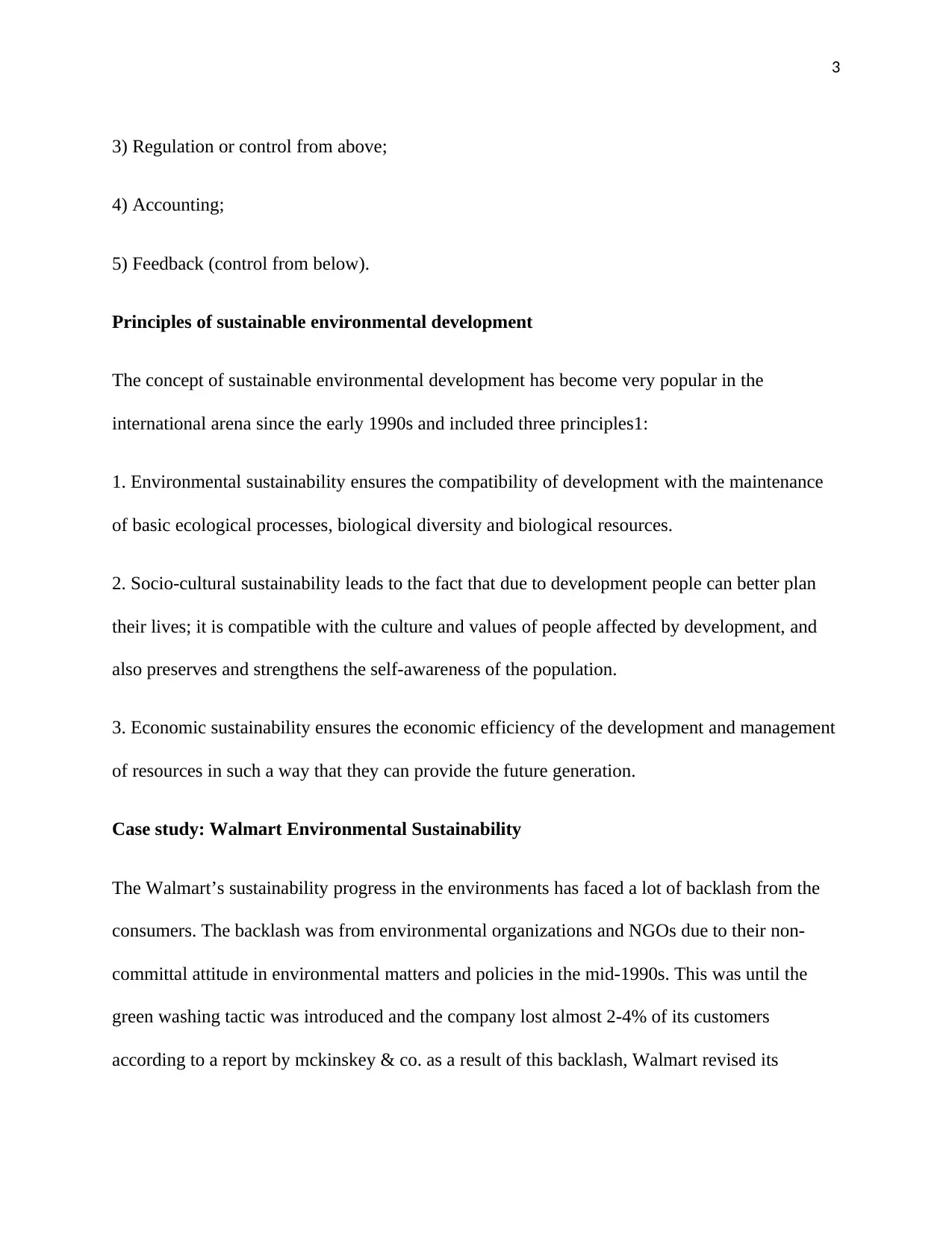
3
3) Regulation or control from above;
4) Accounting;
5) Feedback (control from below).
Principles of sustainable environmental development
The concept of sustainable environmental development has become very popular in the
international arena since the early 1990s and included three principles1:
1. Environmental sustainability ensures the compatibility of development with the maintenance
of basic ecological processes, biological diversity and biological resources.
2. Socio-cultural sustainability leads to the fact that due to development people can better plan
their lives; it is compatible with the culture and values of people affected by development, and
also preserves and strengthens the self-awareness of the population.
3. Economic sustainability ensures the economic efficiency of the development and management
of resources in such a way that they can provide the future generation.
Case study: Walmart Environmental Sustainability
The Walmart’s sustainability progress in the environments has faced a lot of backlash from the
consumers. The backlash was from environmental organizations and NGOs due to their non-
committal attitude in environmental matters and policies in the mid-1990s. This was until the
green washing tactic was introduced and the company lost almost 2-4% of its customers
according to a report by mckinskey & co. as a result of this backlash, Walmart revised its
3) Regulation or control from above;
4) Accounting;
5) Feedback (control from below).
Principles of sustainable environmental development
The concept of sustainable environmental development has become very popular in the
international arena since the early 1990s and included three principles1:
1. Environmental sustainability ensures the compatibility of development with the maintenance
of basic ecological processes, biological diversity and biological resources.
2. Socio-cultural sustainability leads to the fact that due to development people can better plan
their lives; it is compatible with the culture and values of people affected by development, and
also preserves and strengthens the self-awareness of the population.
3. Economic sustainability ensures the economic efficiency of the development and management
of resources in such a way that they can provide the future generation.
Case study: Walmart Environmental Sustainability
The Walmart’s sustainability progress in the environments has faced a lot of backlash from the
consumers. The backlash was from environmental organizations and NGOs due to their non-
committal attitude in environmental matters and policies in the mid-1990s. This was until the
green washing tactic was introduced and the company lost almost 2-4% of its customers
according to a report by mckinskey & co. as a result of this backlash, Walmart revised its
⊘ This is a preview!⊘
Do you want full access?
Subscribe today to unlock all pages.

Trusted by 1+ million students worldwide
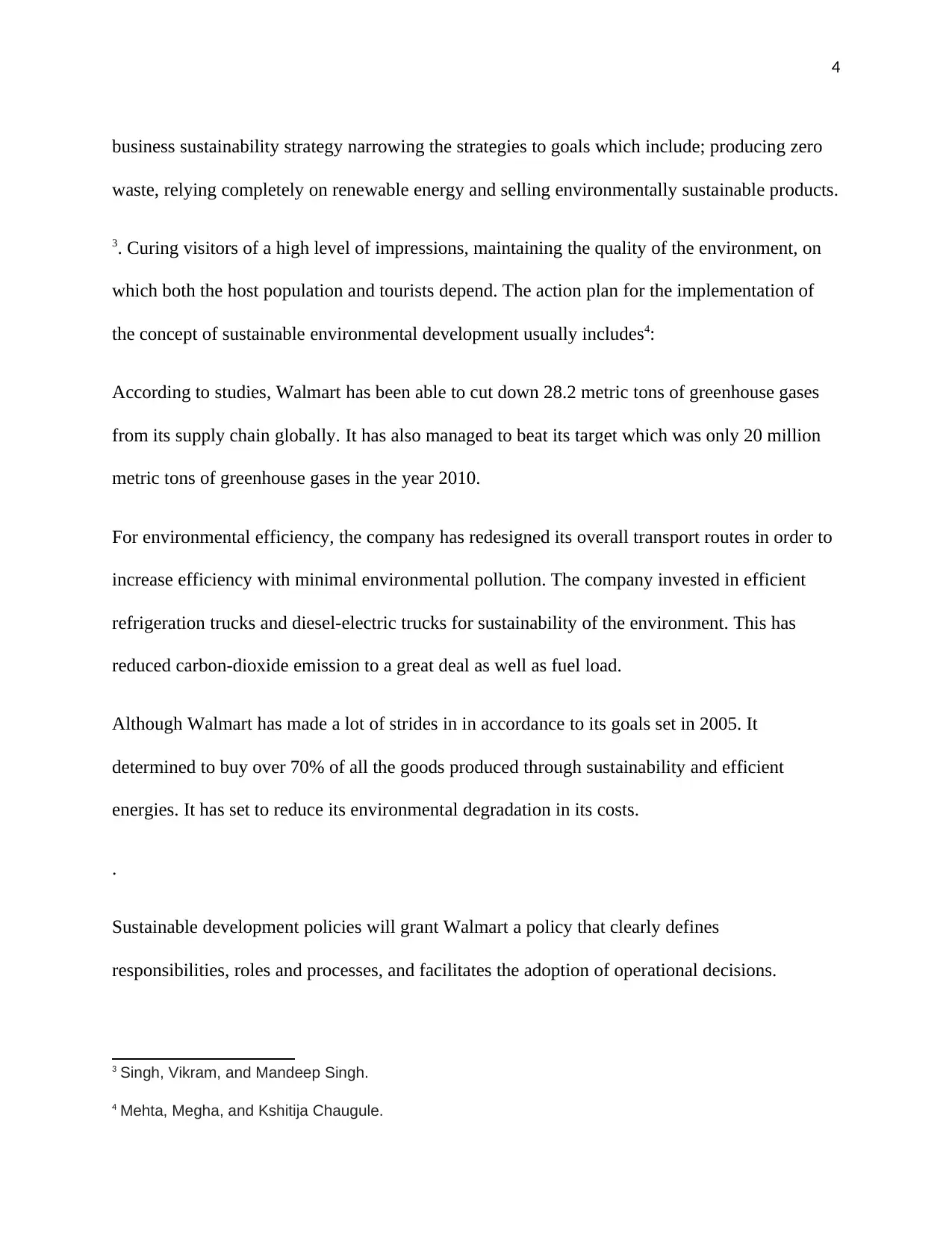
4
business sustainability strategy narrowing the strategies to goals which include; producing zero
waste, relying completely on renewable energy and selling environmentally sustainable products.
3. Curing visitors of a high level of impressions, maintaining the quality of the environment, on
which both the host population and tourists depend. The action plan for the implementation of
the concept of sustainable environmental development usually includes4:
According to studies, Walmart has been able to cut down 28.2 metric tons of greenhouse gases
from its supply chain globally. It has also managed to beat its target which was only 20 million
metric tons of greenhouse gases in the year 2010.
For environmental efficiency, the company has redesigned its overall transport routes in order to
increase efficiency with minimal environmental pollution. The company invested in efficient
refrigeration trucks and diesel-electric trucks for sustainability of the environment. This has
reduced carbon-dioxide emission to a great deal as well as fuel load.
Although Walmart has made a lot of strides in in accordance to its goals set in 2005. It
determined to buy over 70% of all the goods produced through sustainability and efficient
energies. It has set to reduce its environmental degradation in its costs.
.
Sustainable development policies will grant Walmart a policy that clearly defines
responsibilities, roles and processes, and facilitates the adoption of operational decisions.
3 Singh, Vikram, and Mandeep Singh.
4 Mehta, Megha, and Kshitija Chaugule.
business sustainability strategy narrowing the strategies to goals which include; producing zero
waste, relying completely on renewable energy and selling environmentally sustainable products.
3. Curing visitors of a high level of impressions, maintaining the quality of the environment, on
which both the host population and tourists depend. The action plan for the implementation of
the concept of sustainable environmental development usually includes4:
According to studies, Walmart has been able to cut down 28.2 metric tons of greenhouse gases
from its supply chain globally. It has also managed to beat its target which was only 20 million
metric tons of greenhouse gases in the year 2010.
For environmental efficiency, the company has redesigned its overall transport routes in order to
increase efficiency with minimal environmental pollution. The company invested in efficient
refrigeration trucks and diesel-electric trucks for sustainability of the environment. This has
reduced carbon-dioxide emission to a great deal as well as fuel load.
Although Walmart has made a lot of strides in in accordance to its goals set in 2005. It
determined to buy over 70% of all the goods produced through sustainability and efficient
energies. It has set to reduce its environmental degradation in its costs.
.
Sustainable development policies will grant Walmart a policy that clearly defines
responsibilities, roles and processes, and facilitates the adoption of operational decisions.
3 Singh, Vikram, and Mandeep Singh.
4 Mehta, Megha, and Kshitija Chaugule.
Paraphrase This Document
Need a fresh take? Get an instant paraphrase of this document with our AI Paraphraser
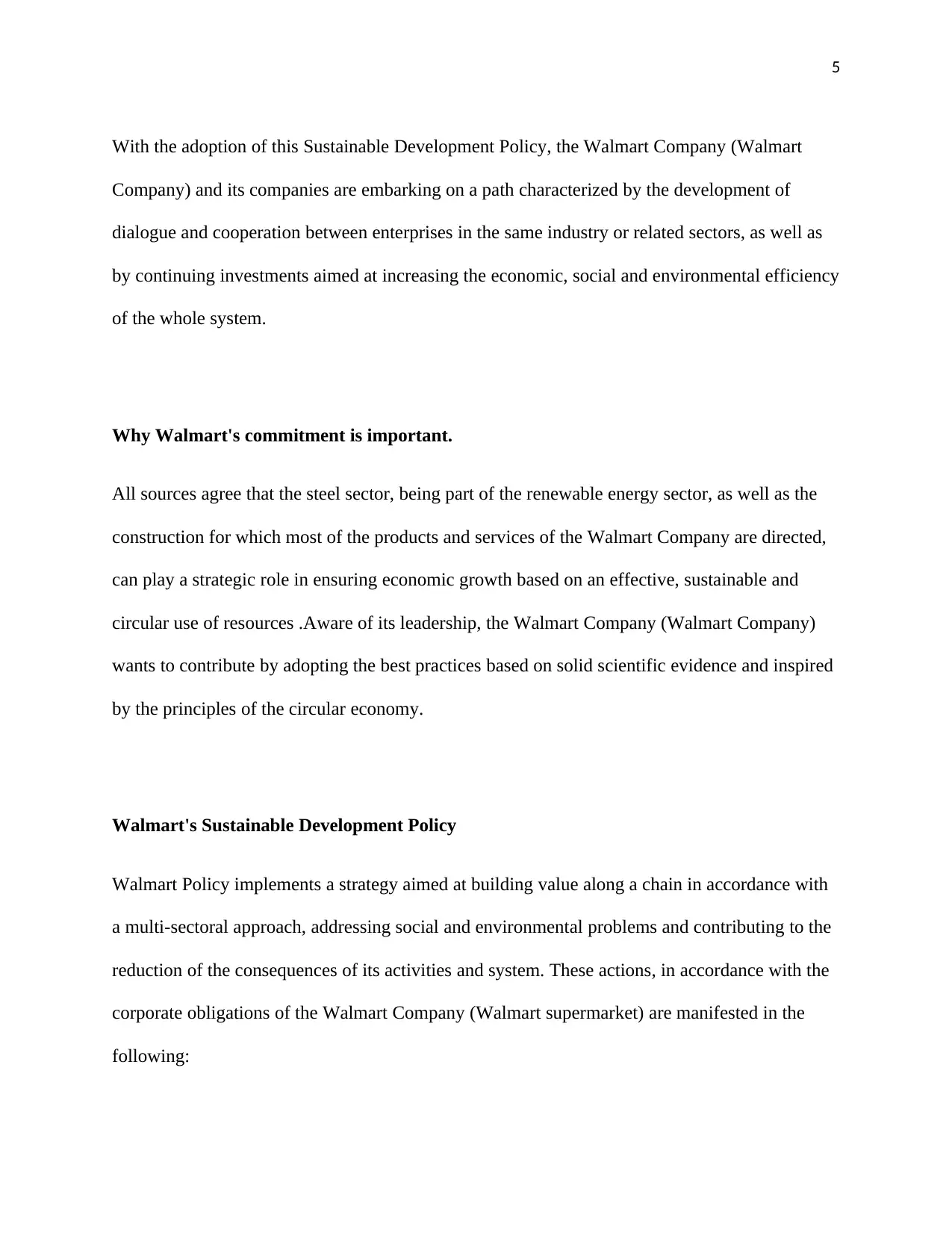
5
With the adoption of this Sustainable Development Policy, the Walmart Company (Walmart
Company) and its companies are embarking on a path characterized by the development of
dialogue and cooperation between enterprises in the same industry or related sectors, as well as
by continuing investments aimed at increasing the economic, social and environmental efficiency
of the whole system.
Why Walmart's commitment is important.
All sources agree that the steel sector, being part of the renewable energy sector, as well as the
construction for which most of the products and services of the Walmart Company are directed,
can play a strategic role in ensuring economic growth based on an effective, sustainable and
circular use of resources .Aware of its leadership, the Walmart Company (Walmart Company)
wants to contribute by adopting the best practices based on solid scientific evidence and inspired
by the principles of the circular economy.
Walmart's Sustainable Development Policy
Walmart Policy implements a strategy aimed at building value along a chain in accordance with
a multi-sectoral approach, addressing social and environmental problems and contributing to the
reduction of the consequences of its activities and system. These actions, in accordance with the
corporate obligations of the Walmart Company (Walmart supermarket) are manifested in the
following:
With the adoption of this Sustainable Development Policy, the Walmart Company (Walmart
Company) and its companies are embarking on a path characterized by the development of
dialogue and cooperation between enterprises in the same industry or related sectors, as well as
by continuing investments aimed at increasing the economic, social and environmental efficiency
of the whole system.
Why Walmart's commitment is important.
All sources agree that the steel sector, being part of the renewable energy sector, as well as the
construction for which most of the products and services of the Walmart Company are directed,
can play a strategic role in ensuring economic growth based on an effective, sustainable and
circular use of resources .Aware of its leadership, the Walmart Company (Walmart Company)
wants to contribute by adopting the best practices based on solid scientific evidence and inspired
by the principles of the circular economy.
Walmart's Sustainable Development Policy
Walmart Policy implements a strategy aimed at building value along a chain in accordance with
a multi-sectoral approach, addressing social and environmental problems and contributing to the
reduction of the consequences of its activities and system. These actions, in accordance with the
corporate obligations of the Walmart Company (Walmart supermarket) are manifested in the
following:
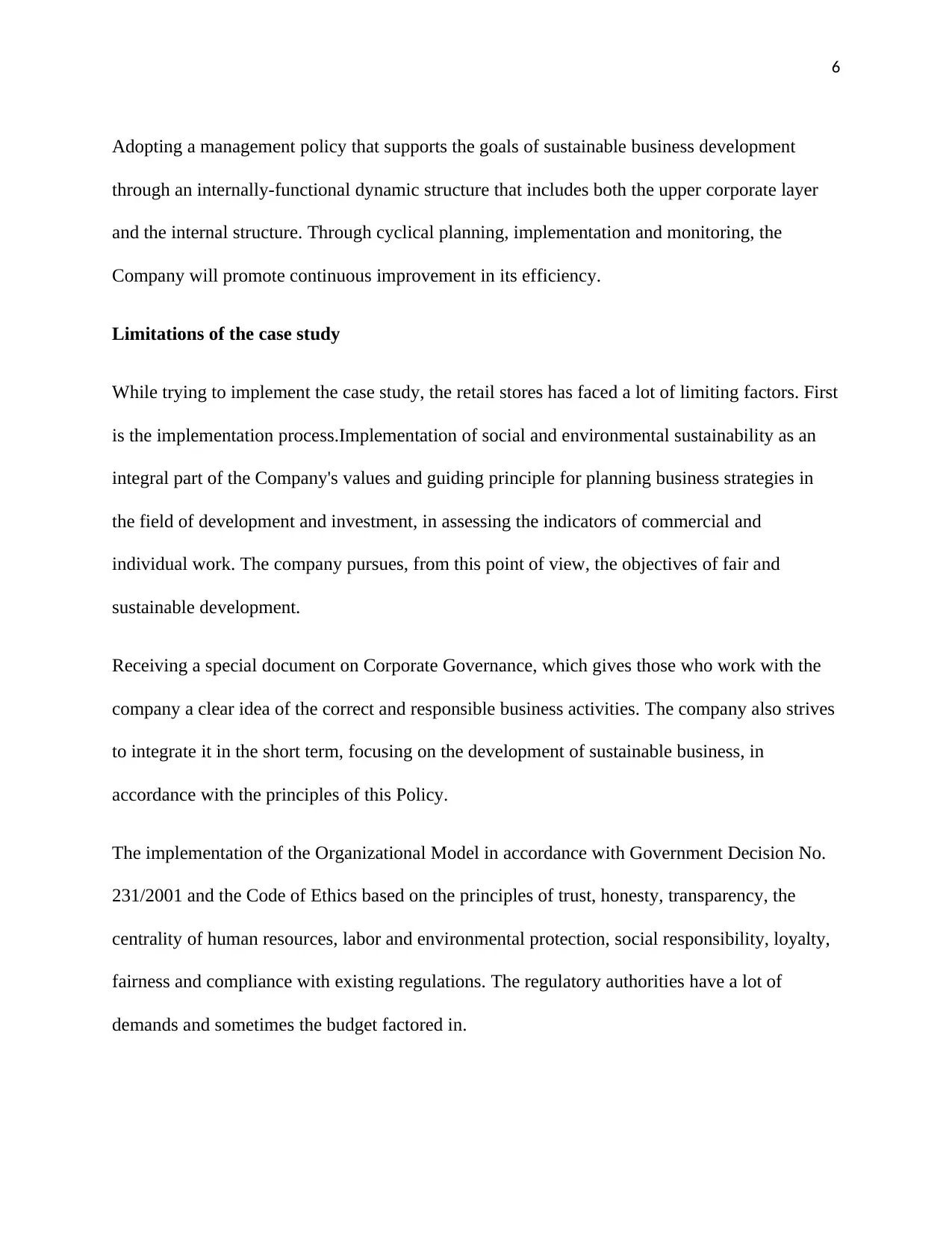
6
Adopting a management policy that supports the goals of sustainable business development
through an internally-functional dynamic structure that includes both the upper corporate layer
and the internal structure. Through cyclical planning, implementation and monitoring, the
Company will promote continuous improvement in its efficiency.
Limitations of the case study
While trying to implement the case study, the retail stores has faced a lot of limiting factors. First
is the implementation process.Implementation of social and environmental sustainability as an
integral part of the Company's values and guiding principle for planning business strategies in
the field of development and investment, in assessing the indicators of commercial and
individual work. The company pursues, from this point of view, the objectives of fair and
sustainable development.
Receiving a special document on Corporate Governance, which gives those who work with the
company a clear idea of the correct and responsible business activities. The company also strives
to integrate it in the short term, focusing on the development of sustainable business, in
accordance with the principles of this Policy.
The implementation of the Organizational Model in accordance with Government Decision No.
231/2001 and the Code of Ethics based on the principles of trust, honesty, transparency, the
centrality of human resources, labor and environmental protection, social responsibility, loyalty,
fairness and compliance with existing regulations. The regulatory authorities have a lot of
demands and sometimes the budget factored in.
Adopting a management policy that supports the goals of sustainable business development
through an internally-functional dynamic structure that includes both the upper corporate layer
and the internal structure. Through cyclical planning, implementation and monitoring, the
Company will promote continuous improvement in its efficiency.
Limitations of the case study
While trying to implement the case study, the retail stores has faced a lot of limiting factors. First
is the implementation process.Implementation of social and environmental sustainability as an
integral part of the Company's values and guiding principle for planning business strategies in
the field of development and investment, in assessing the indicators of commercial and
individual work. The company pursues, from this point of view, the objectives of fair and
sustainable development.
Receiving a special document on Corporate Governance, which gives those who work with the
company a clear idea of the correct and responsible business activities. The company also strives
to integrate it in the short term, focusing on the development of sustainable business, in
accordance with the principles of this Policy.
The implementation of the Organizational Model in accordance with Government Decision No.
231/2001 and the Code of Ethics based on the principles of trust, honesty, transparency, the
centrality of human resources, labor and environmental protection, social responsibility, loyalty,
fairness and compliance with existing regulations. The regulatory authorities have a lot of
demands and sometimes the budget factored in.
⊘ This is a preview!⊘
Do you want full access?
Subscribe today to unlock all pages.

Trusted by 1+ million students worldwide
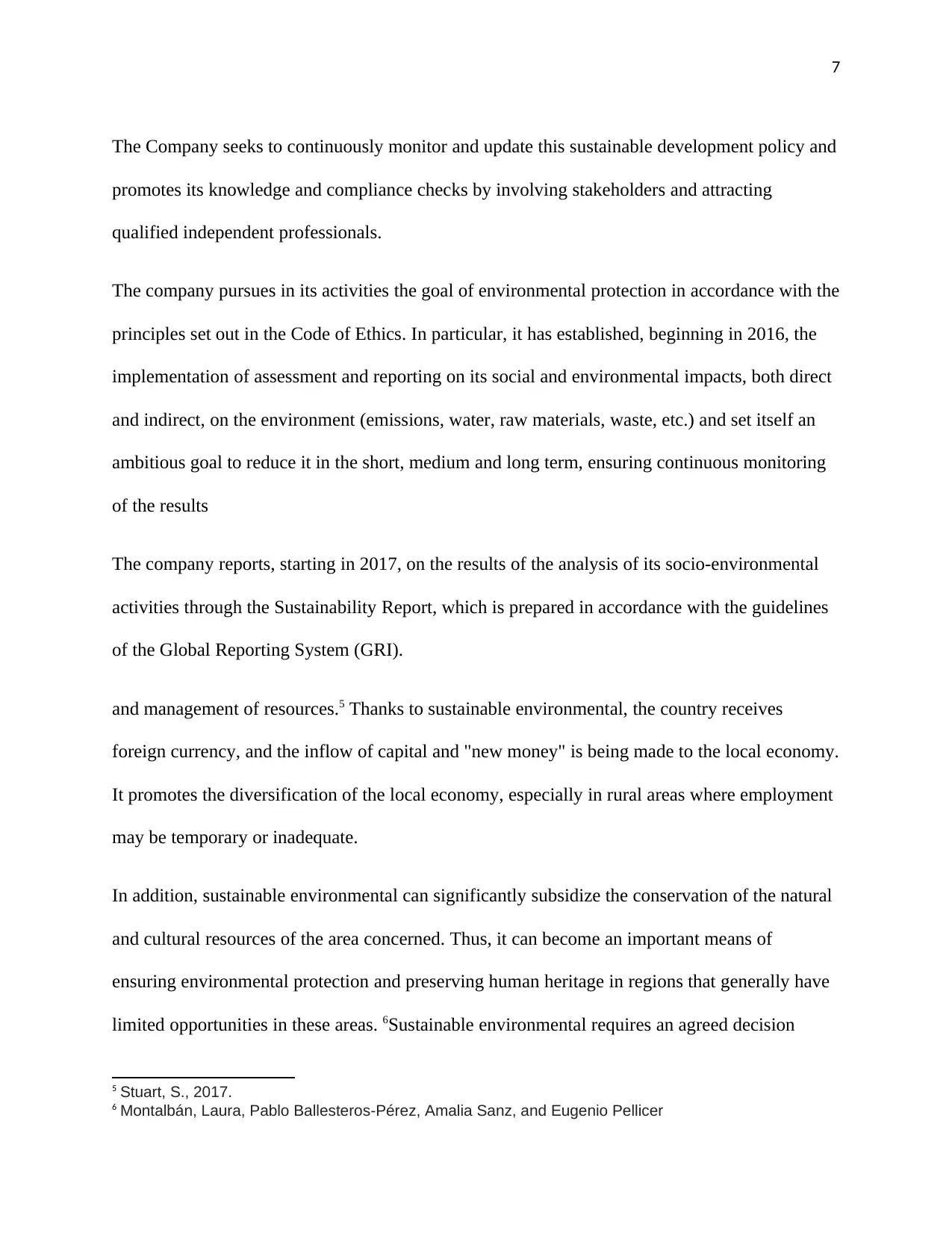
7
The Company seeks to continuously monitor and update this sustainable development policy and
promotes its knowledge and compliance checks by involving stakeholders and attracting
qualified independent professionals.
The company pursues in its activities the goal of environmental protection in accordance with the
principles set out in the Code of Ethics. In particular, it has established, beginning in 2016, the
implementation of assessment and reporting on its social and environmental impacts, both direct
and indirect, on the environment (emissions, water, raw materials, waste, etc.) and set itself an
ambitious goal to reduce it in the short, medium and long term, ensuring continuous monitoring
of the results
The company reports, starting in 2017, on the results of the analysis of its socio-environmental
activities through the Sustainability Report, which is prepared in accordance with the guidelines
of the Global Reporting System (GRI).
and management of resources.5 Thanks to sustainable environmental, the country receives
foreign currency, and the inflow of capital and "new money" is being made to the local economy.
It promotes the diversification of the local economy, especially in rural areas where employment
may be temporary or inadequate.
In addition, sustainable environmental can significantly subsidize the conservation of the natural
and cultural resources of the area concerned. Thus, it can become an important means of
ensuring environmental protection and preserving human heritage in regions that generally have
limited opportunities in these areas. 6Sustainable environmental requires an agreed decision
5 Stuart, S., 2017.
6 Montalbán, Laura, Pablo Ballesteros-Pérez, Amalia Sanz, and Eugenio Pellicer
The Company seeks to continuously monitor and update this sustainable development policy and
promotes its knowledge and compliance checks by involving stakeholders and attracting
qualified independent professionals.
The company pursues in its activities the goal of environmental protection in accordance with the
principles set out in the Code of Ethics. In particular, it has established, beginning in 2016, the
implementation of assessment and reporting on its social and environmental impacts, both direct
and indirect, on the environment (emissions, water, raw materials, waste, etc.) and set itself an
ambitious goal to reduce it in the short, medium and long term, ensuring continuous monitoring
of the results
The company reports, starting in 2017, on the results of the analysis of its socio-environmental
activities through the Sustainability Report, which is prepared in accordance with the guidelines
of the Global Reporting System (GRI).
and management of resources.5 Thanks to sustainable environmental, the country receives
foreign currency, and the inflow of capital and "new money" is being made to the local economy.
It promotes the diversification of the local economy, especially in rural areas where employment
may be temporary or inadequate.
In addition, sustainable environmental can significantly subsidize the conservation of the natural
and cultural resources of the area concerned. Thus, it can become an important means of
ensuring environmental protection and preserving human heritage in regions that generally have
limited opportunities in these areas. 6Sustainable environmental requires an agreed decision
5 Stuart, S., 2017.
6 Montalbán, Laura, Pablo Ballesteros-Pérez, Amalia Sanz, and Eugenio Pellicer
Paraphrase This Document
Need a fresh take? Get an instant paraphrase of this document with our AI Paraphraser
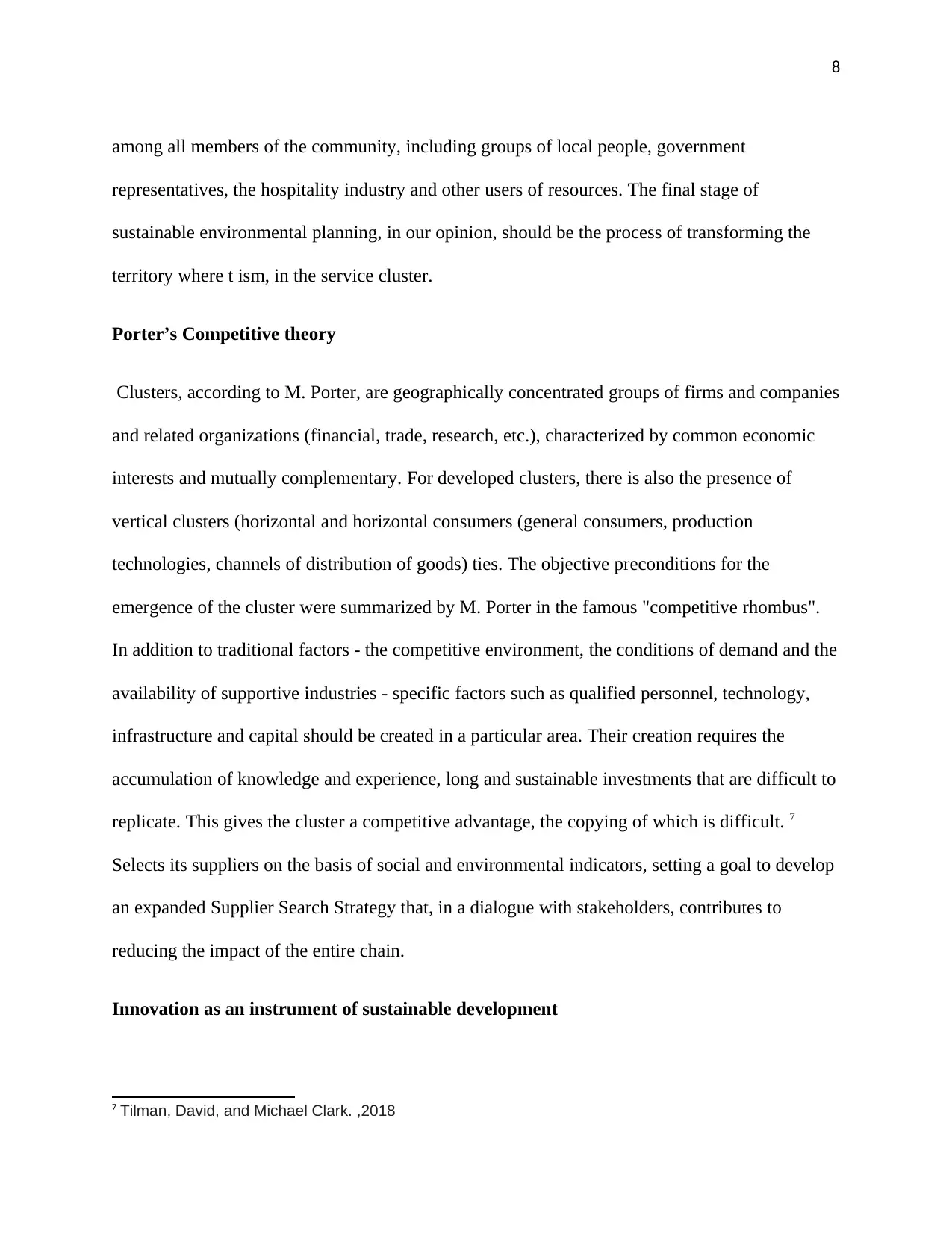
8
among all members of the community, including groups of local people, government
representatives, the hospitality industry and other users of resources. The final stage of
sustainable environmental planning, in our opinion, should be the process of transforming the
territory where t ism, in the service cluster.
Porter’s Competitive theory
Clusters, according to M. Porter, are geographically concentrated groups of firms and companies
and related organizations (financial, trade, research, etc.), characterized by common economic
interests and mutually complementary. For developed clusters, there is also the presence of
vertical clusters (horizontal and horizontal consumers (general consumers, production
technologies, channels of distribution of goods) ties. The objective preconditions for the
emergence of the cluster were summarized by M. Porter in the famous "competitive rhombus".
In addition to traditional factors - the competitive environment, the conditions of demand and the
availability of supportive industries - specific factors such as qualified personnel, technology,
infrastructure and capital should be created in a particular area. Their creation requires the
accumulation of knowledge and experience, long and sustainable investments that are difficult to
replicate. This gives the cluster a competitive advantage, the copying of which is difficult. 7
Selects its suppliers on the basis of social and environmental indicators, setting a goal to develop
an expanded Supplier Search Strategy that, in a dialogue with stakeholders, contributes to
reducing the impact of the entire chain.
Innovation as an instrument of sustainable development
7 Tilman, David, and Michael Clark. ,2018
among all members of the community, including groups of local people, government
representatives, the hospitality industry and other users of resources. The final stage of
sustainable environmental planning, in our opinion, should be the process of transforming the
territory where t ism, in the service cluster.
Porter’s Competitive theory
Clusters, according to M. Porter, are geographically concentrated groups of firms and companies
and related organizations (financial, trade, research, etc.), characterized by common economic
interests and mutually complementary. For developed clusters, there is also the presence of
vertical clusters (horizontal and horizontal consumers (general consumers, production
technologies, channels of distribution of goods) ties. The objective preconditions for the
emergence of the cluster were summarized by M. Porter in the famous "competitive rhombus".
In addition to traditional factors - the competitive environment, the conditions of demand and the
availability of supportive industries - specific factors such as qualified personnel, technology,
infrastructure and capital should be created in a particular area. Their creation requires the
accumulation of knowledge and experience, long and sustainable investments that are difficult to
replicate. This gives the cluster a competitive advantage, the copying of which is difficult. 7
Selects its suppliers on the basis of social and environmental indicators, setting a goal to develop
an expanded Supplier Search Strategy that, in a dialogue with stakeholders, contributes to
reducing the impact of the entire chain.
Innovation as an instrument of sustainable development
7 Tilman, David, and Michael Clark. ,2018
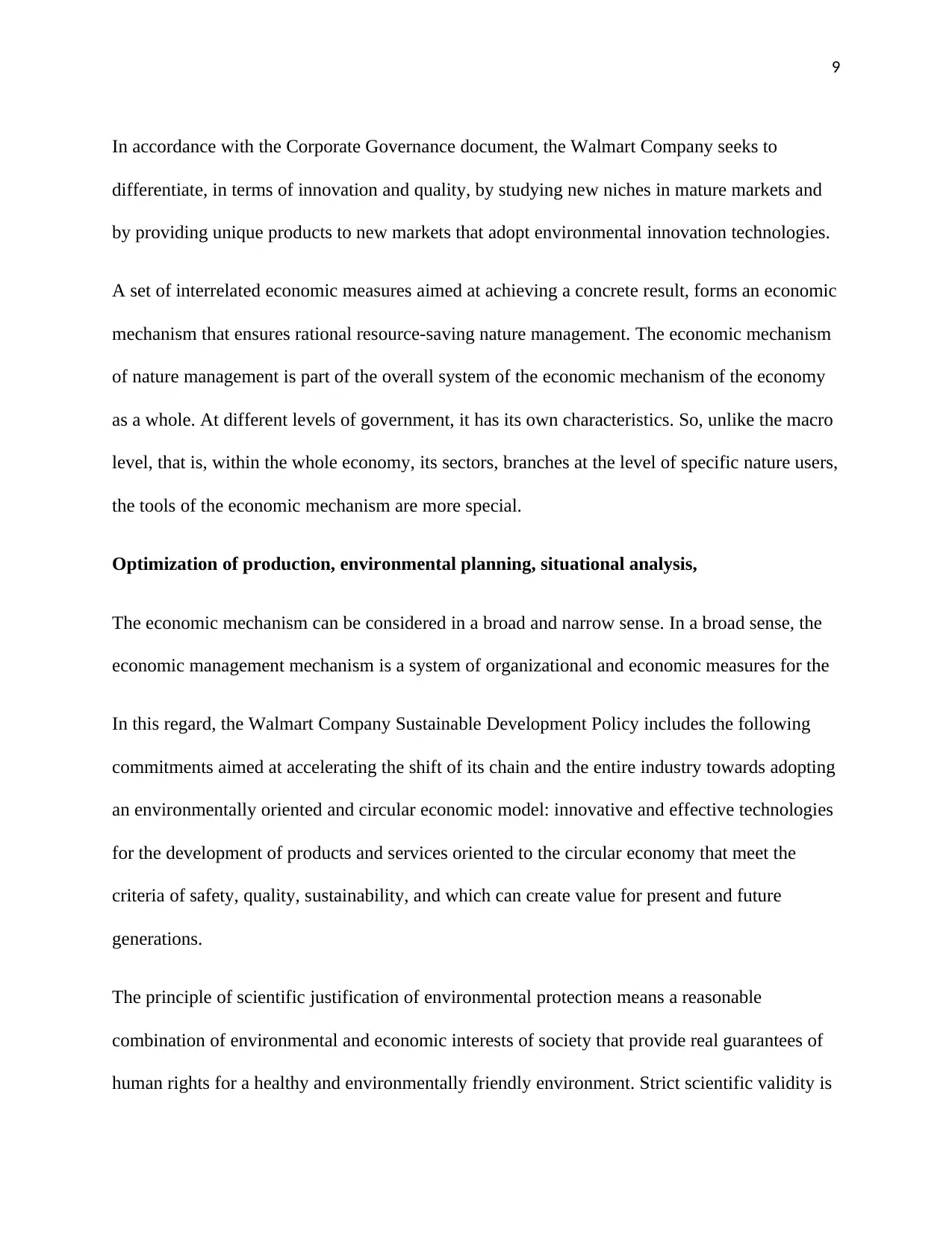
9
In accordance with the Corporate Governance document, the Walmart Company seeks to
differentiate, in terms of innovation and quality, by studying new niches in mature markets and
by providing unique products to new markets that adopt environmental innovation technologies.
A set of interrelated economic measures aimed at achieving a concrete result, forms an economic
mechanism that ensures rational resource-saving nature management. The economic mechanism
of nature management is part of the overall system of the economic mechanism of the economy
as a whole. At different levels of government, it has its own characteristics. So, unlike the macro
level, that is, within the whole economy, its sectors, branches at the level of specific nature users,
the tools of the economic mechanism are more special.
Optimization of production, environmental planning, situational analysis,
The economic mechanism can be considered in a broad and narrow sense. In a broad sense, the
economic management mechanism is a system of organizational and economic measures for the
In this regard, the Walmart Company Sustainable Development Policy includes the following
commitments aimed at accelerating the shift of its chain and the entire industry towards adopting
an environmentally oriented and circular economic model: innovative and effective technologies
for the development of products and services oriented to the circular economy that meet the
criteria of safety, quality, sustainability, and which can create value for present and future
generations.
The principle of scientific justification of environmental protection means a reasonable
combination of environmental and economic interests of society that provide real guarantees of
human rights for a healthy and environmentally friendly environment. Strict scientific validity is
In accordance with the Corporate Governance document, the Walmart Company seeks to
differentiate, in terms of innovation and quality, by studying new niches in mature markets and
by providing unique products to new markets that adopt environmental innovation technologies.
A set of interrelated economic measures aimed at achieving a concrete result, forms an economic
mechanism that ensures rational resource-saving nature management. The economic mechanism
of nature management is part of the overall system of the economic mechanism of the economy
as a whole. At different levels of government, it has its own characteristics. So, unlike the macro
level, that is, within the whole economy, its sectors, branches at the level of specific nature users,
the tools of the economic mechanism are more special.
Optimization of production, environmental planning, situational analysis,
The economic mechanism can be considered in a broad and narrow sense. In a broad sense, the
economic management mechanism is a system of organizational and economic measures for the
In this regard, the Walmart Company Sustainable Development Policy includes the following
commitments aimed at accelerating the shift of its chain and the entire industry towards adopting
an environmentally oriented and circular economic model: innovative and effective technologies
for the development of products and services oriented to the circular economy that meet the
criteria of safety, quality, sustainability, and which can create value for present and future
generations.
The principle of scientific justification of environmental protection means a reasonable
combination of environmental and economic interests of society that provide real guarantees of
human rights for a healthy and environmentally friendly environment. Strict scientific validity is
⊘ This is a preview!⊘
Do you want full access?
Subscribe today to unlock all pages.

Trusted by 1+ million students worldwide
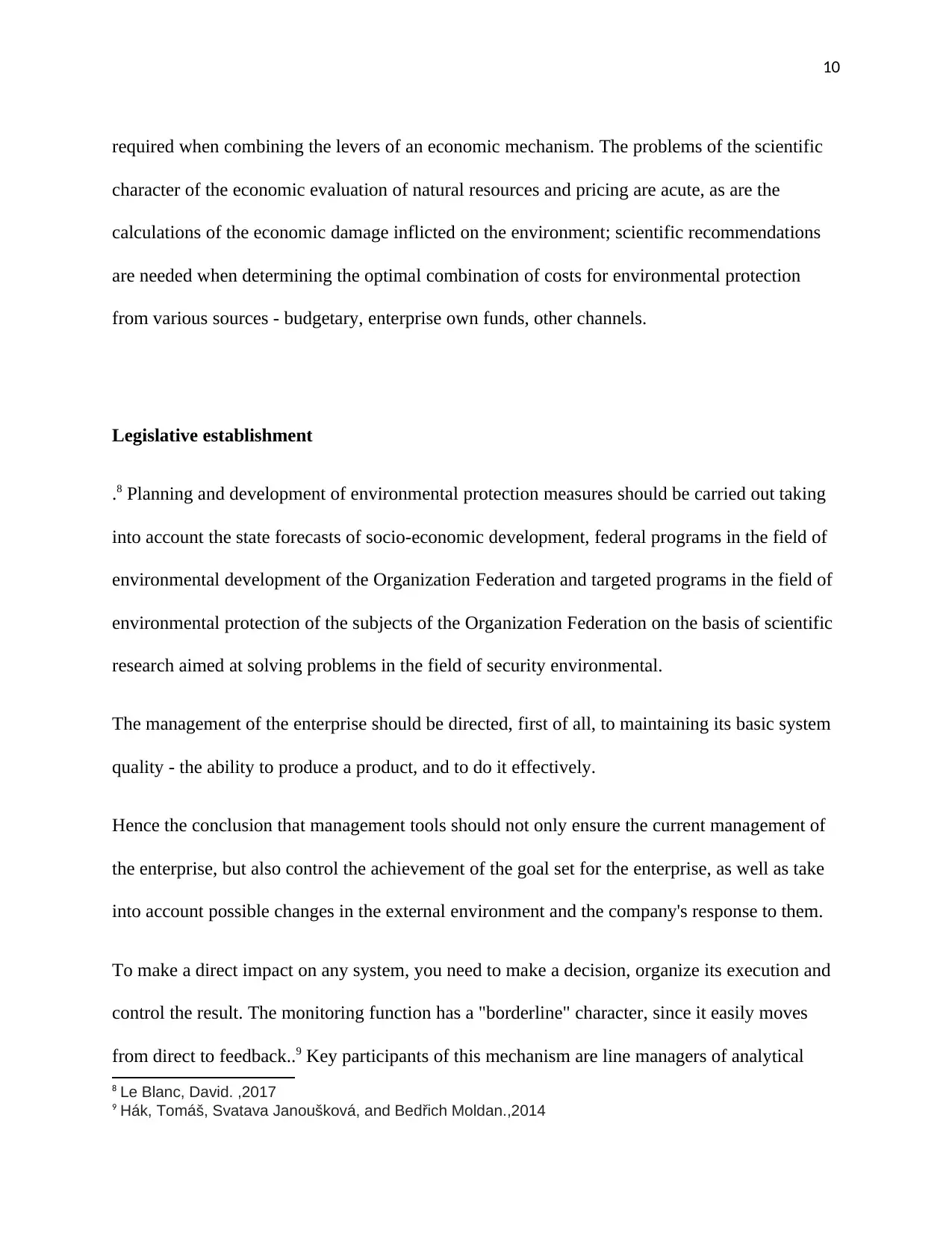
10
required when combining the levers of an economic mechanism. The problems of the scientific
character of the economic evaluation of natural resources and pricing are acute, as are the
calculations of the economic damage inflicted on the environment; scientific recommendations
are needed when determining the optimal combination of costs for environmental protection
from various sources - budgetary, enterprise own funds, other channels.
Legislative establishment
.8 Planning and development of environmental protection measures should be carried out taking
into account the state forecasts of socio-economic development, federal programs in the field of
environmental development of the Organization Federation and targeted programs in the field of
environmental protection of the subjects of the Organization Federation on the basis of scientific
research aimed at solving problems in the field of security environmental.
The management of the enterprise should be directed, first of all, to maintaining its basic system
quality - the ability to produce a product, and to do it effectively.
Hence the conclusion that management tools should not only ensure the current management of
the enterprise, but also control the achievement of the goal set for the enterprise, as well as take
into account possible changes in the external environment and the company's response to them.
To make a direct impact on any system, you need to make a decision, organize its execution and
control the result. The monitoring function has a "borderline" character, since it easily moves
from direct to feedback..9 Key participants of this mechanism are line managers of analytical
8 Le Blanc, David. ,2017
9 Hák, Tomáš, Svatava Janoušková, and Bedřich Moldan.,2014
required when combining the levers of an economic mechanism. The problems of the scientific
character of the economic evaluation of natural resources and pricing are acute, as are the
calculations of the economic damage inflicted on the environment; scientific recommendations
are needed when determining the optimal combination of costs for environmental protection
from various sources - budgetary, enterprise own funds, other channels.
Legislative establishment
.8 Planning and development of environmental protection measures should be carried out taking
into account the state forecasts of socio-economic development, federal programs in the field of
environmental development of the Organization Federation and targeted programs in the field of
environmental protection of the subjects of the Organization Federation on the basis of scientific
research aimed at solving problems in the field of security environmental.
The management of the enterprise should be directed, first of all, to maintaining its basic system
quality - the ability to produce a product, and to do it effectively.
Hence the conclusion that management tools should not only ensure the current management of
the enterprise, but also control the achievement of the goal set for the enterprise, as well as take
into account possible changes in the external environment and the company's response to them.
To make a direct impact on any system, you need to make a decision, organize its execution and
control the result. The monitoring function has a "borderline" character, since it easily moves
from direct to feedback..9 Key participants of this mechanism are line managers of analytical
8 Le Blanc, David. ,2017
9 Hák, Tomáš, Svatava Janoušková, and Bedřich Moldan.,2014
Paraphrase This Document
Need a fresh take? Get an instant paraphrase of this document with our AI Paraphraser
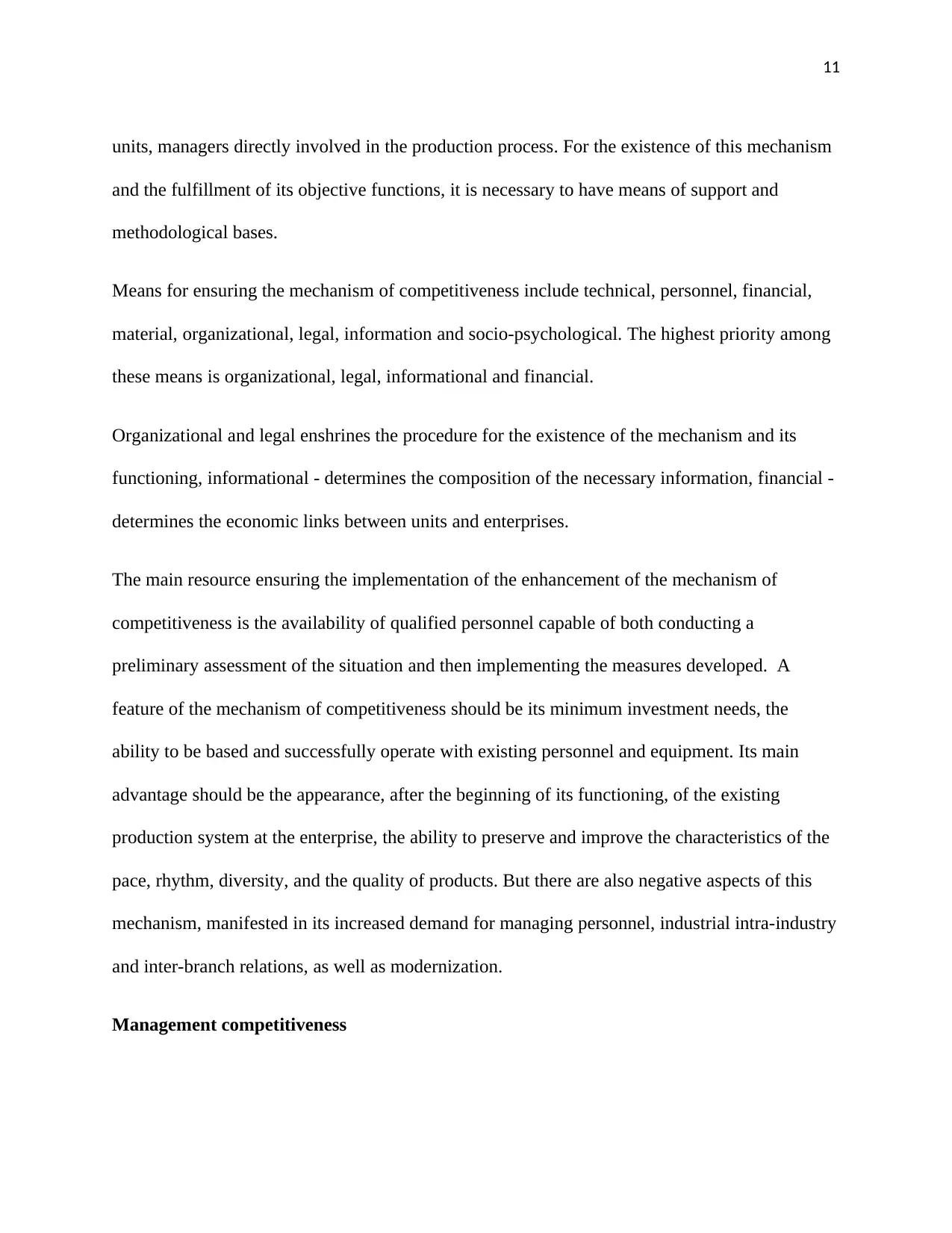
11
units, managers directly involved in the production process. For the existence of this mechanism
and the fulfillment of its objective functions, it is necessary to have means of support and
methodological bases.
Means for ensuring the mechanism of competitiveness include technical, personnel, financial,
material, organizational, legal, information and socio-psychological. The highest priority among
these means is organizational, legal, informational and financial.
Organizational and legal enshrines the procedure for the existence of the mechanism and its
functioning, informational - determines the composition of the necessary information, financial -
determines the economic links between units and enterprises.
The main resource ensuring the implementation of the enhancement of the mechanism of
competitiveness is the availability of qualified personnel capable of both conducting a
preliminary assessment of the situation and then implementing the measures developed. A
feature of the mechanism of competitiveness should be its minimum investment needs, the
ability to be based and successfully operate with existing personnel and equipment. Its main
advantage should be the appearance, after the beginning of its functioning, of the existing
production system at the enterprise, the ability to preserve and improve the characteristics of the
pace, rhythm, diversity, and the quality of products. But there are also negative aspects of this
mechanism, manifested in its increased demand for managing personnel, industrial intra-industry
and inter-branch relations, as well as modernization.
Management competitiveness
units, managers directly involved in the production process. For the existence of this mechanism
and the fulfillment of its objective functions, it is necessary to have means of support and
methodological bases.
Means for ensuring the mechanism of competitiveness include technical, personnel, financial,
material, organizational, legal, information and socio-psychological. The highest priority among
these means is organizational, legal, informational and financial.
Organizational and legal enshrines the procedure for the existence of the mechanism and its
functioning, informational - determines the composition of the necessary information, financial -
determines the economic links between units and enterprises.
The main resource ensuring the implementation of the enhancement of the mechanism of
competitiveness is the availability of qualified personnel capable of both conducting a
preliminary assessment of the situation and then implementing the measures developed. A
feature of the mechanism of competitiveness should be its minimum investment needs, the
ability to be based and successfully operate with existing personnel and equipment. Its main
advantage should be the appearance, after the beginning of its functioning, of the existing
production system at the enterprise, the ability to preserve and improve the characteristics of the
pace, rhythm, diversity, and the quality of products. But there are also negative aspects of this
mechanism, manifested in its increased demand for managing personnel, industrial intra-industry
and inter-branch relations, as well as modernization.
Management competitiveness
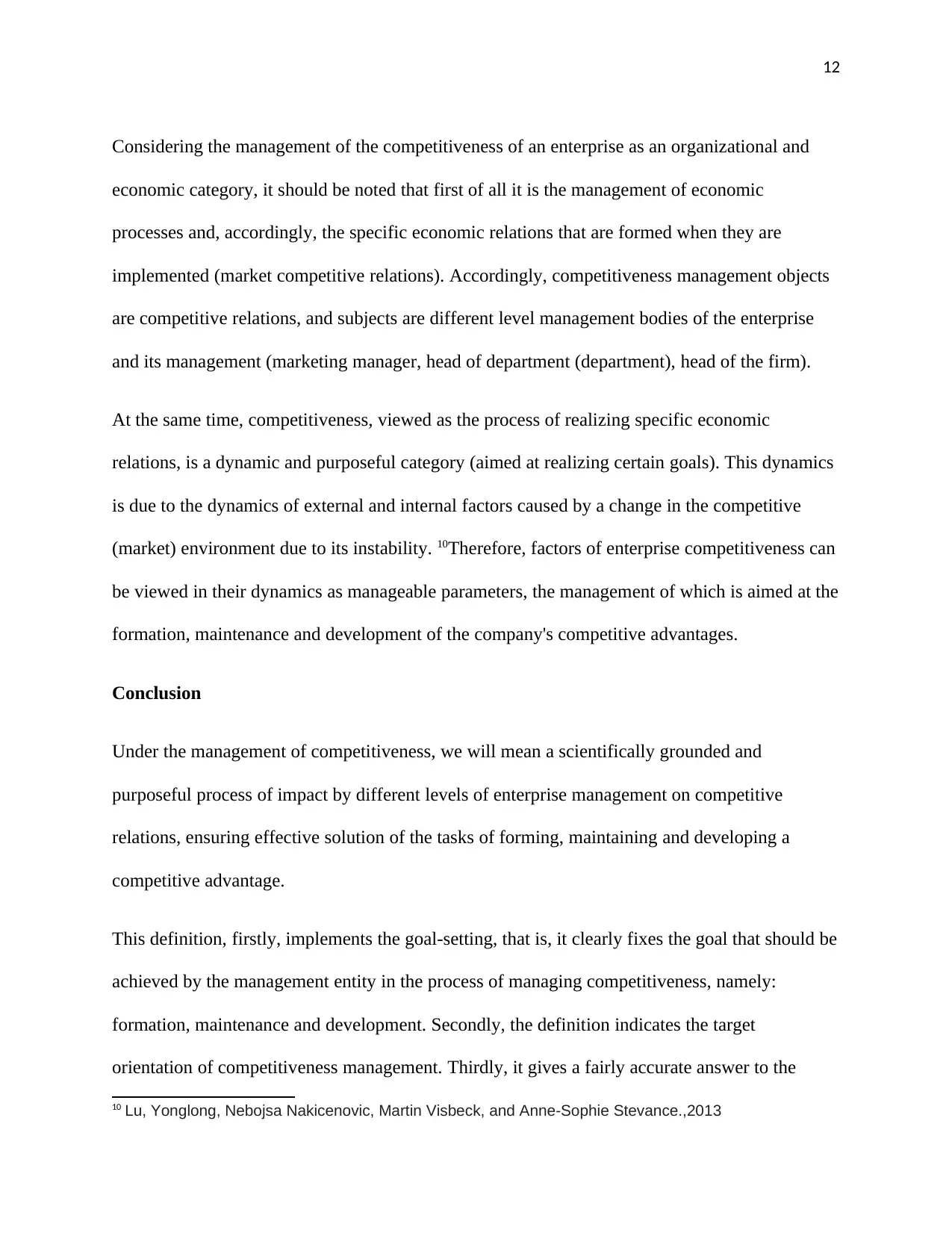
12
Considering the management of the competitiveness of an enterprise as an organizational and
economic category, it should be noted that first of all it is the management of economic
processes and, accordingly, the specific economic relations that are formed when they are
implemented (market competitive relations). Accordingly, competitiveness management objects
are competitive relations, and subjects are different level management bodies of the enterprise
and its management (marketing manager, head of department (department), head of the firm).
At the same time, competitiveness, viewed as the process of realizing specific economic
relations, is a dynamic and purposeful category (aimed at realizing certain goals). This dynamics
is due to the dynamics of external and internal factors caused by a change in the competitive
(market) environment due to its instability. 10Therefore, factors of enterprise competitiveness can
be viewed in their dynamics as manageable parameters, the management of which is aimed at the
formation, maintenance and development of the company's competitive advantages.
Conclusion
Under the management of competitiveness, we will mean a scientifically grounded and
purposeful process of impact by different levels of enterprise management on competitive
relations, ensuring effective solution of the tasks of forming, maintaining and developing a
competitive advantage.
This definition, firstly, implements the goal-setting, that is, it clearly fixes the goal that should be
achieved by the management entity in the process of managing competitiveness, namely:
formation, maintenance and development. Secondly, the definition indicates the target
orientation of competitiveness management. Thirdly, it gives a fairly accurate answer to the
10 Lu, Yonglong, Nebojsa Nakicenovic, Martin Visbeck, and Anne-Sophie Stevance.,2013
Considering the management of the competitiveness of an enterprise as an organizational and
economic category, it should be noted that first of all it is the management of economic
processes and, accordingly, the specific economic relations that are formed when they are
implemented (market competitive relations). Accordingly, competitiveness management objects
are competitive relations, and subjects are different level management bodies of the enterprise
and its management (marketing manager, head of department (department), head of the firm).
At the same time, competitiveness, viewed as the process of realizing specific economic
relations, is a dynamic and purposeful category (aimed at realizing certain goals). This dynamics
is due to the dynamics of external and internal factors caused by a change in the competitive
(market) environment due to its instability. 10Therefore, factors of enterprise competitiveness can
be viewed in their dynamics as manageable parameters, the management of which is aimed at the
formation, maintenance and development of the company's competitive advantages.
Conclusion
Under the management of competitiveness, we will mean a scientifically grounded and
purposeful process of impact by different levels of enterprise management on competitive
relations, ensuring effective solution of the tasks of forming, maintaining and developing a
competitive advantage.
This definition, firstly, implements the goal-setting, that is, it clearly fixes the goal that should be
achieved by the management entity in the process of managing competitiveness, namely:
formation, maintenance and development. Secondly, the definition indicates the target
orientation of competitiveness management. Thirdly, it gives a fairly accurate answer to the
10 Lu, Yonglong, Nebojsa Nakicenovic, Martin Visbeck, and Anne-Sophie Stevance.,2013
⊘ This is a preview!⊘
Do you want full access?
Subscribe today to unlock all pages.

Trusted by 1+ million students worldwide
1 out of 16
Related Documents
Your All-in-One AI-Powered Toolkit for Academic Success.
+13062052269
info@desklib.com
Available 24*7 on WhatsApp / Email
![[object Object]](/_next/static/media/star-bottom.7253800d.svg)
Unlock your academic potential
Copyright © 2020–2025 A2Z Services. All Rights Reserved. Developed and managed by ZUCOL.




